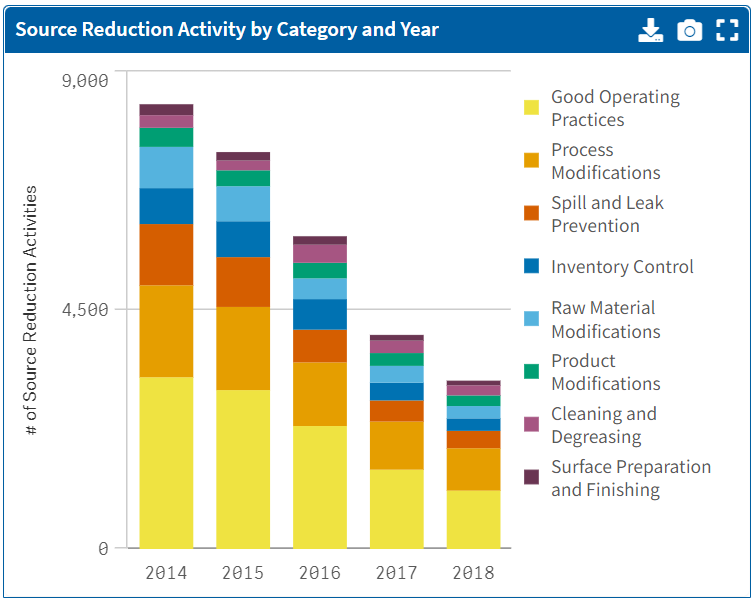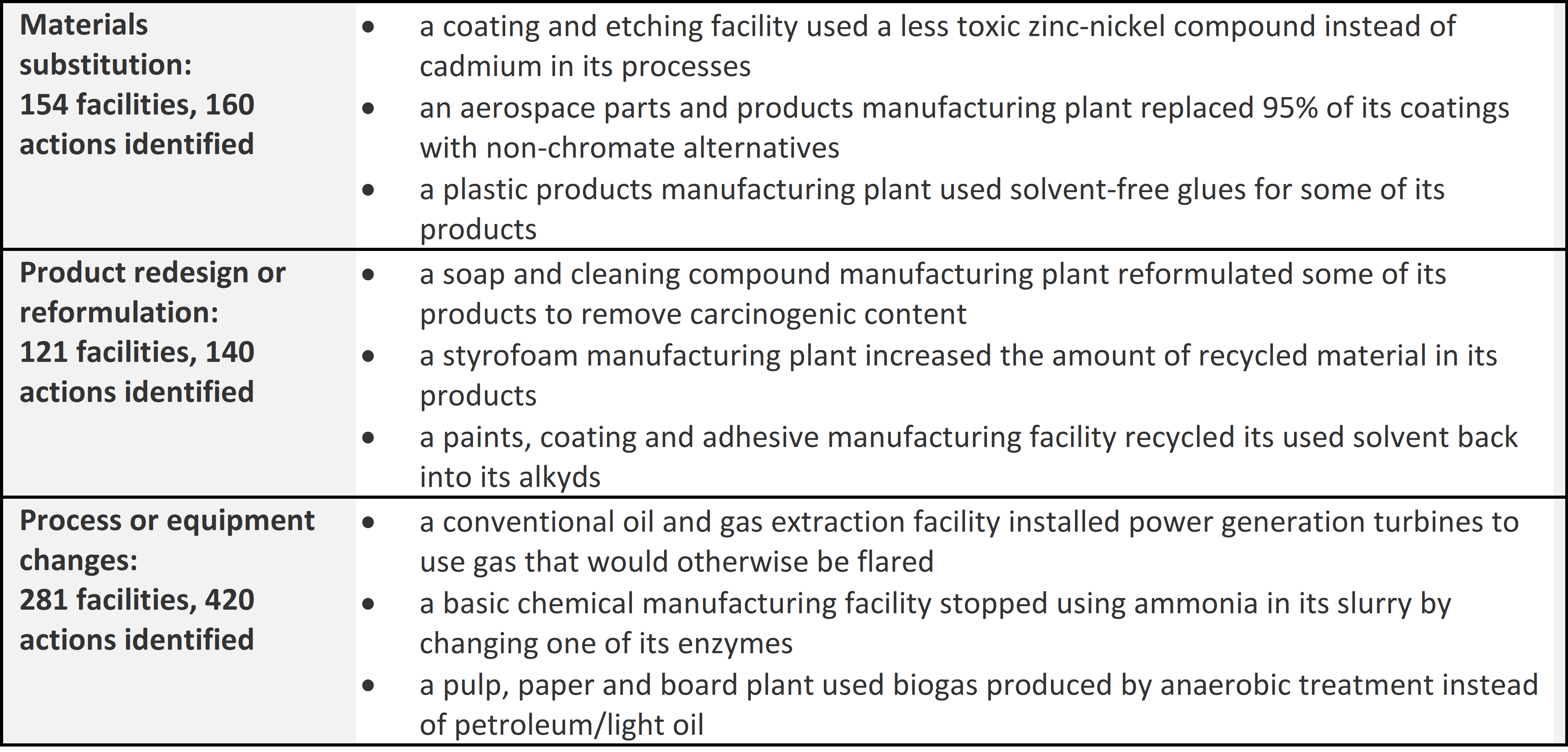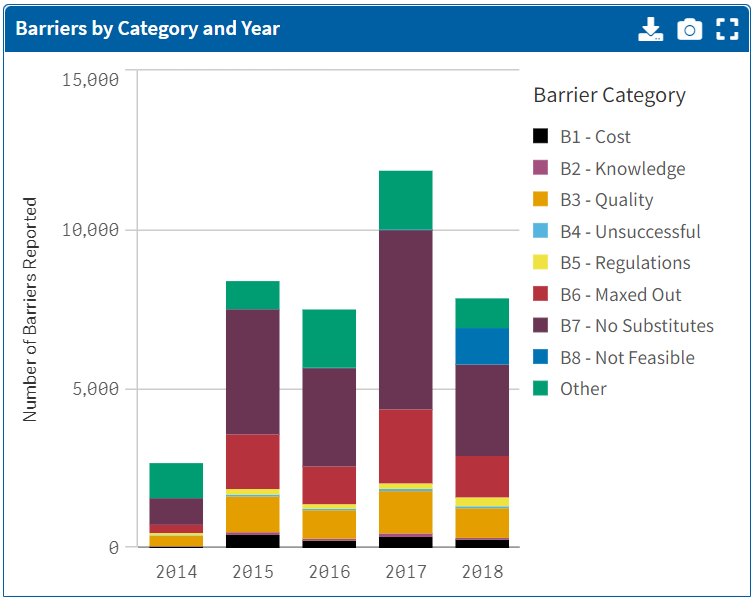2 Feature Analysis: Off-site Transfers to Disposal in North America, 2014–2018
2.5 Sustainable Production and Alternatives to the Generation and Disposal of Industrial Waste
2.5.3 The role of PRTR programs in the circular economy
As governments recognize the need for a fundamental paradigm shift in our patterns of production and consumption, i.e., from a linear economy to a circular economy, there is a corresponding need to support the transition within industry from pollution management to avoiding the creation of pollution in the first place, to effectively protect the environment and human health, eliminate costly waste, and achieve sustainable development. The three North American governments have developed strategies, policies, programs, and resources to support this transition. As described in greater detail below, these include certification and awards programs and guidance to industry sectors on best available practices, and so on.
The unique features of PRTRs enable the tracking of the sources, types and amounts of pollutants generated and used in industrial processes, and subsequently released or transferred as waste. As such, these national programs can play a stronger role in supporting the implementation of sustainable practices.[83] As mentioned in section 2.3, part of the information reported by North American facilities relates to their implementation of pollution prevention and sustainable production strategies and actions. This information is being compiled and used by the PRTR programs of the region to track progress toward industrial sustainability and better understand related challenges and possible solutions.
Figure 28 presents the source reduction activities reported by US facilities between 2014 and 2018.
Figure 28. Source Reduction Activities reported by US Facilities, 2014–2018

Source: TRI Toxics Tracker Tool – Number of Source Reduction Activities, 2014–2018 (accessed 10 June 2022).
Similarly, examples of Canadian facilities’ implementation of pollution prevention and green chemistry practices are compiled and presented in the “Pollution Prevention Resource Finder,” (P2 Finder) an online tool hosted by ECCC. Table 43 shows examples of pollution prevention practices reported to NPRI for 2017.[84] Reporting of pollutant-specific pollution prevention activities became mandatory under the NPRI as of 2021.
Table 43. Examples of Pollution Prevention Activities Reported to NPRI, 2017

Source: Government of Canada 2019, Pollution Prevention Resource Finder, ECCC (accessed 10 June 2022).
Notwithstanding the above examples, however, there are challenges facing the adoption on a wider scale of sustainable practices within industry. These include the cost of implementation; lack of knowledge about best practices and available technologies; constraints relating to material and product specifications and consumer preferences; reluctance on the part of management; and so on. Adding to these challenges is the limited knowledge and information on the part of governments regarding the needs of the industrial and productive sectors and the potential range of approaches and solutions.
Some PRTR programs are helping to shed light on these issues. For example, since 2014 the US TRI has been compiling and making available online information provided by facilities relative to the barriers they face when attempting to implement source reduction activities and other sustainable practices (Figure 29).
Figure 29. Barriers to the Implementation of Source Reduction Activities and Green Chemistry, TRI (2014–2018)

Source: TRI Toxics Tracker Tool – Analysis of Barriers to the Implementation of Green Chemistry and Source Reduction Activities, 2014–2018 (accessed 10 June 2022).
This information can be used by industry, governments, and other stakeholders to better understand the needs of specific sectors and develop strategies and resources to address these needs. Increasingly, existing industry resources and experiences from around the world can be easily shared and accessed online. Examples include the pollution prevention case studies, fact sheets, handbooks, and databases available through the EPA’s “P2 Resources Search” page and ECCC’s Pollution Prevention Resource Finder, featuring information from North America and elsewhere.[85]
[83] See the 2021 OECD report on how PRTRs can support progress towards sustainability.
[84] Government of Canada. 2019. Pollution Prevention: How to green your business by preventing pollution, ECCC.
[85] EPA, P2 Resources Search, and ECCC, Pollution Prevention Resource Finder